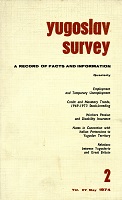CREDIT AND MONETARY TRENDS, 1969—1973 (IN YUGOSLAVIA)
CREDIT AND MONETARY TRENDS, 1969—1973 (IN YUGOSLAVIA)
Author(s): Radoslav VuksanovićSubject(s): National Economy, Supranational / Global Economy, Economic history, Economic policy, Socio-Economic Research
Published by: Jugoslovenski Pregled
Keywords: Credit; Monetary policy; Economic policy; Supply of money;
Summary/Abstract: In the period 1969—1973, credit and monetary trends depended on the measures of credit and monetary policy, which was every year formulated in line with the current economic policy of the country. In keeping with the economy’s requirements, credit and monetary policy was aimed at ensuring a sufficient supply of money for the unhindered involvement of production and trade, and at maintaining economic stability. The credit and monetary policy pursued up to 1971 was designed to curb demand, but it was not sufficiently backed by other measures of economic policy. Restrictive measures in the monetary and credit sector had a restraining effect on the high rise in demand, but also an adverse effect on the liquidity of the economy. Because of this, monetary restrictions were slackened in 1972 and 1973 and the credit and monetary policy was, in the context of other measures of economic policy, directed at the elimination of illiquidity, which, however, in its turn resulted in monetary expansion reflected in a high increase in money supply.
Journal: Yugoslav Survey. A Record of Facts and Information
- Issue Year: XV/1974
- Issue No: 2
- Page Range: 41-54
- Page Count: 14
- Language: English

